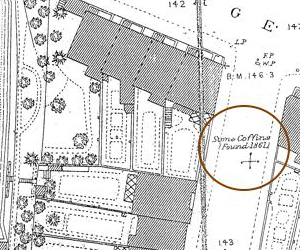Waking the Dead
Two stone coffins from Roman times were unearthed in the roadway near the Bathwick Hill end of Sydney Buildings in 1861. One contained the remains of a young woman, the other those of a teenager. Unusually, both bodies were packed in white sand, and in one case there are reports that tiny pieces of fabric were preserved in the sand.

Section of the 1886 map showing the roadway site
Earlier, in 1832, a stone coffin had been found in the garden of 2 Sydney Buildings. It contained a heavily decayed female skeleton. Nearby finds included pottery, glass and a small silver coin tentatively dated as third century A.D. What happened to this coffin and the other two, and to their contents, is something the History Group hopes to find out.
In Roman times it was usual for burials to take place outside towns and settlements, in cemetery areas bordering existing roads. The spread of archaeological finds in the Bathwick area, mostly in the flatter ground below the line of the present-day railway, tends to confirm that a well-used Roman road traversed the area. Its exact route is not known, but it is thought to have run from a crossing of the Avon near the end of Walcot Street, via Henrietta and Sydney Gardens, to the high ground around Sham Castle.
Sources of information
Roman Bath discovered by Barry Cunliffe, 1984 edition, Routledge & Keegan Paul.
Bathwick: A forgotten village, 2004, The Bathwick Local History Society.
B&NES Sites and Monuments Record Office, Trimbridge House, Trim St., Bath
The two records relating to the Sydney Buildings site held by the Bath & North East Somerset Council can be seen by clicking here.
Chris Morrissey.
July 2009
Sydney Buildings History Group ©
UpBack